stop start Alfa Romeo 156 2007 Owner handbook (in English)
[x] Cancel search | Manufacturer: ALFA ROMEO, Model Year: 2007, Model line: 156, Model: Alfa Romeo 156 2007Pages: 357, PDF Size: 5.04 MB
Page 155 of 357

GETTING TO KNOW YOUR CAR
153
In an emergency (failures, flat battery,
etc.), it is possible to move the lever from
position P, pressing the special mechanical
button under the gearshift lever cover, in the
area (A-fig. 135); at the same time
move the lever from position Pto the re-
quired position. If the engine is being
started, move the lever to position N, which
is the only one that allows this operation
in this case.
WARNINGThe ignition key in the
STOPposition can only be removed from
the ignition switch provided that the
gearshift lever is at P(Key-lock).In an emergency (failures, flat battery,
etc.), it is possible to remove the ignition
key also with the selector lever not posi-
tioned at P.
Press the release device (A-fig. 136),
next to the ignition switch inside the trim,
with your finger removing the key at the
same time.
Do not take the car to peak performance
until the engine has reached normal oper-
ating temperature.fig. 135
A0B0267m
fig. 136
A0B0266m
fig. 137
A0B0385m
SELECTING AUTOMATIC/
MANUAL GEARSHIFTINGThe main feature of this gearbox is the pos-
sibility of using it either automatically or
manually. The choice of the operating mode
is carried out positioning the gearshift lever
in the right sector (automatic gearshifting)
or in the left sector (manual gearshifting).
The gearbox operating mode and the gear
engaged are shown on the display inside the
rev counter (A-fig. 137).
Page 160 of 357
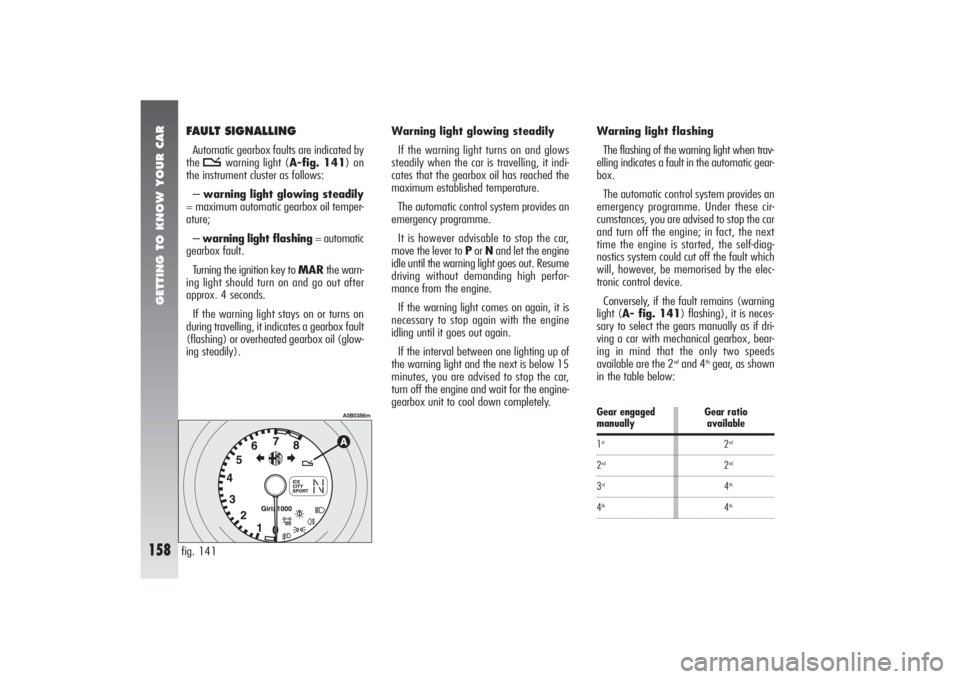
GETTING TO KNOW YOUR CAR
158
1st2nd3rd4th
2nd2nd4th4th
Gear engaged Gear ratiomanually available
FAULT SIGNALLINGAutomatic gearbox faults are indicated by
the t
warning light (A-fig. 141) on
the instrument cluster as follows:
–warning light glowing steadily
= maximum automatic gearbox oil temper-
ature;
–warning light flashing= automatic
gearbox fault.
Turning the ignition key to MARthe warn-
ing light should turn on and go out after
approx. 4 seconds.
If the warning light stays on or turns on
during travelling, it indicates a gearbox fault
(flashing) or overheated gearbox oil (glow-
ing steadily).Warning light glowing steadily
If the warning light turns on and glows
steadily when the car is travelling, it indi-
cates that the gearbox oil has reached the
maximum established temperature.
The automatic control system provides an
emergency programme.
It is however advisable to stop the car,
move the lever to Por Nand let the engine
idle until the warning light goes out. Resume
driving without demanding high perfor-
mance from the engine.
If the warning light comes on again, it is
necessary to stop again with the engine
idling until it goes out again.
If the interval between one lighting up of
the warning light and the next is below 15
minutes, you are advised to stop the car,
turn off the engine and wait for the engine-
gearbox unit to cool down completely.
fig. 141
A0B0386m
Warning light flashing
The flashing of the warning light when trav-
elling indicates a fault in the automatic gear-
box.
The automatic control system provides an
emergency programme. Under these cir-
cumstances, you are advised to stop the car
and turn off the engine; in fact, the next
time the engine is started, the self-diag-
nostics system could cut off the fault which
will, however, be memorised by the elec-
tronic control device.
Conversely, if the fault remains (warning
light (A- fig. 141) flashing), it is neces-
sary to select the gears manually as if dri-
ving a car with mechanical gearbox, bear-
ing in mind that the only two speeds
available are the 2
ndand 4
thgear, as shown
in the table below:
Page 164 of 357

GETTING TO KNOW YOUR CAR
162
CEILING LIGHTS The car is fitted with passenger’s com-
partment ceiling lights (front/rear) with
gradual switching on/off. Timings, defined
as max. switching on time elapsing between
the end of gradual switching on and the start
of gradual switching off are as follows:
1)approx. 6 seconds when:
– unlocking the doors manually or by the
remote control
– closing the driver’s door to get into the
car and fit the key into the ignition switch
– removing the key from the ignition
switch.
2)approx. 3 minutes from the door open-
ing.WARNING With ignition key at STOP
or when opening a door or the tailgate 15
minutes timing is activated, then ceiling
lights go off. Timing restarts each time a
door/tailgate is opened.
Front roof light (fig. 145)
The roof light comprises two lights with the
control switch.
With switch (A) in the central position
(1), both lights turn on when a door is
opened.
When the doors are closed, a timer is ac-
tivated for about 7 seconds, to allow the car
to be started. The lights go out when the ig-
nition key is turned to MAR(with the doors
closed).
Moving switch (A) to the left (position 0),
the lights stay off (position OFF).Moving switch (A) to the right (posi-
tion2) both lights stay on.
The spot function is operated by switch
(B).
Moving switch (B) to the left (position 1)
the left spot light turns on. Moving switch
to the right (position 2) the right spot light
turns on.
With switch (B) in the central position (po-
sition 0) the spotlights stay off.
WARNINGBefore leaving the car, make
sure that both switches are in the central po-
sition. This way, the roof lights will go out
when the doors are closed. If a door is left
open, the lights will go out automatically af-
ter a few seconds.
To turn them on again, simply open an-
other door or close the same one and open
it again.fig. 145
A0B0575m
Page 175 of 357
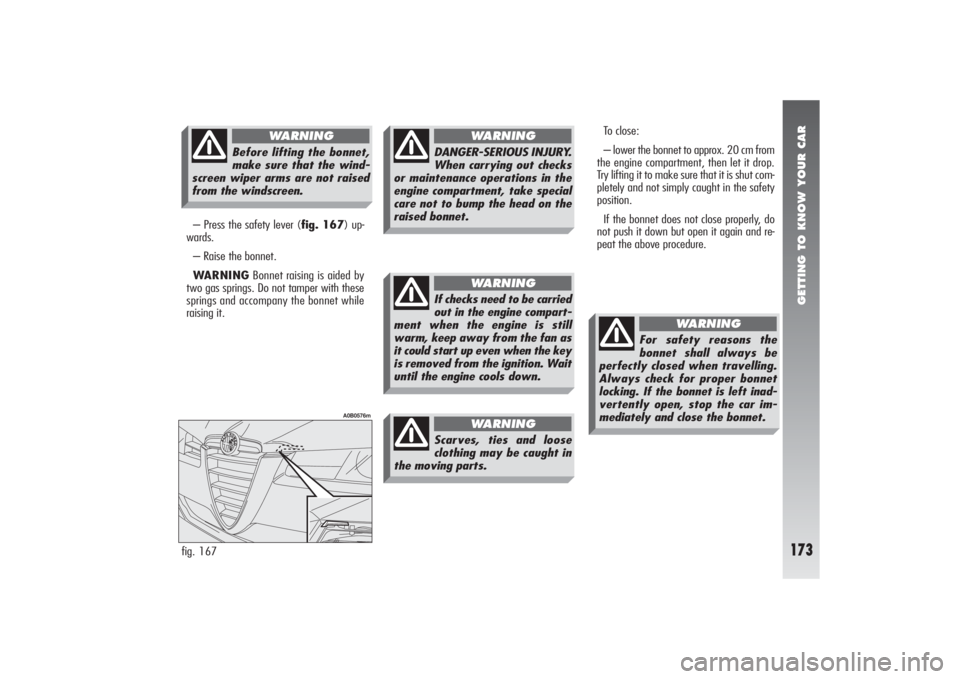
GETTING TO KNOW YOUR CAR
173
– Press the safety lever (fig. 167) up-
wards.
– Raise the bonnet.
WARNINGBonnet raising is aided by
two gas springs. Do not tamper with these
springs and accompany the bonnet while
raising it.
fig. 167
A0B0576m
Before lifting the bonnet,
make sure that the wind-
screen wiper arms are not raised
from the windscreen.
WARNING
DANGER-SERIOUS INJURY.
When carrying out checks
or maintenance operations in the
engine compartment, take special
care not to bump the head on the
raised bonnet.
WARNING
If checks need to be carried
out in the engine compart-
ment when the engine is still
warm, keep away from the fan as
it could start up even when the key
is removed from the ignition. Wait
until the engine cools down.
WARNING
Scarves, ties and loose
clothing may be caught in
the moving parts.
WARNING
To close:
– lower the bonnet to approx. 20 cm from
the engine compartment, then let it drop.
Try lifting it to make sure that it is shut com-
pletely and not simply caught in the safety
position.
If the bonnet does not close properly, do
not push it down but open it again and re-
peat the above procedure.
For safety reasons the
bonnet shall always be
perfectly closed when travelling.
Always check for proper bonnet
locking. If the bonnet is left inad-
vertently open, stop the car im-
mediately and close the bonnet.
WARNING
Page 181 of 357
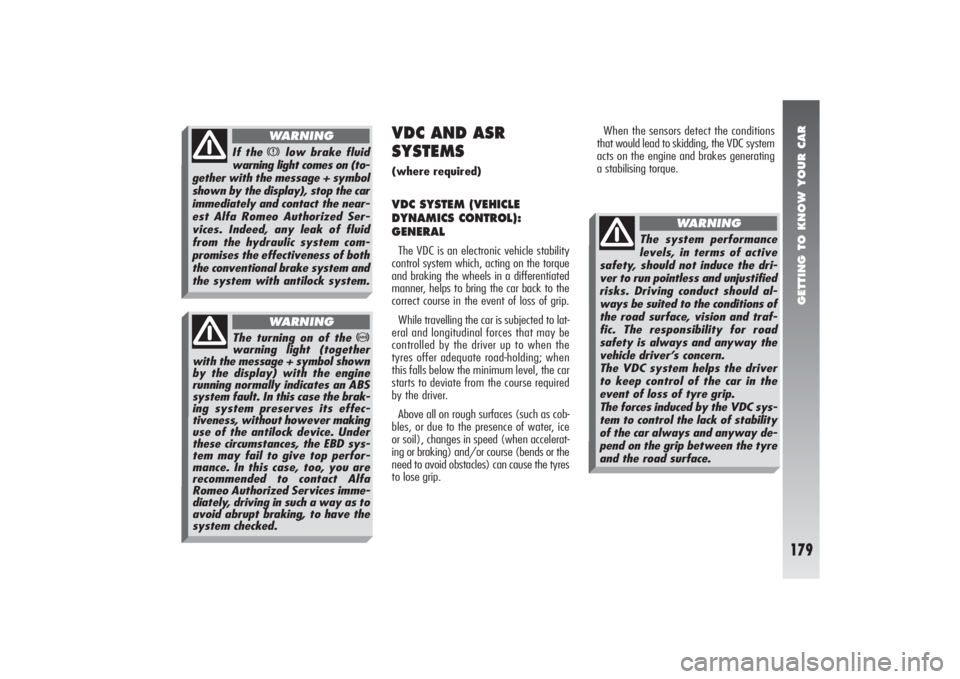
GETTING TO KNOW YOUR CAR
179
If the
x
low brake fluid
warning light comes on (to-
gether with the message + symbol
shown by the display), stop the car
immediately and contact the near-
est Alfa Romeo Authorized Ser-
vices. Indeed, any leak of fluid
from the hydraulic system com-
promises the effectiveness of both
the conventional brake system and
the system with antilock system.
WARNING
The turning on of the
>
warning light (together
with the message + symbol shown
by the display) with the engine
running normally indicates an ABS
system fault. In this case the brak-
ing system preserves its effec-
tiveness, without however making
use of the antilock device. Under
these circumstances, the EBD sys-
tem may fail to give top perfor-
mance. In this case, too, you are
recommended to contact Alfa
Romeo Authorized Services imme-
diately, driving in such a way as to
avoid abrupt braking, to have the
system checked.
WARNING
VDC AND ASR
SYSTEMS(where required)VDC SYSTEM (VEHICLE
DYNAMICS CONTROL):
GENERALThe VDC is an electronic vehicle stability
control system which, acting on the torque
and braking the wheels in a differentiated
manner, helps to bring the car back to the
correct course in the event of loss of grip.
While travelling the car is subjected to lat-
eral and longitudinal forces that may be
controlled by the driver up to when the
tyres offer adequate road-holding; when
this falls below the minimum level, the car
starts to deviate from the course required
by the driver.
Above all on rough surfaces (such as cob-
bles, or due to the presence of water, ice
or soil), changes in speed (when accelerat-
ing or braking) and/or course (bends or the
need to avoid obstacles) can cause the tyres
to lose grip.When the sensors detect the conditions
that would lead to skidding, the VDC system
acts on the engine and brakes generating
a stabilising torque.
The system performance
levels, in terms of active
safety, should not induce the dri-
ver to run pointless and unjustified
risks. Driving conduct should al-
ways be suited to the conditions of
the road surface, vision and traf-
fic. The responsibility for road
safety is always and anyway the
vehicle driver’s concern.
The VDC system helps the driver
to keep control of the car in the
event of loss of tyre grip.
The forces induced by the VDC sys-
tem to control the lack of stability
of the car always and anyway de-
pend on the grip between the tyre
and the road surface.
WARNING
Page 187 of 357
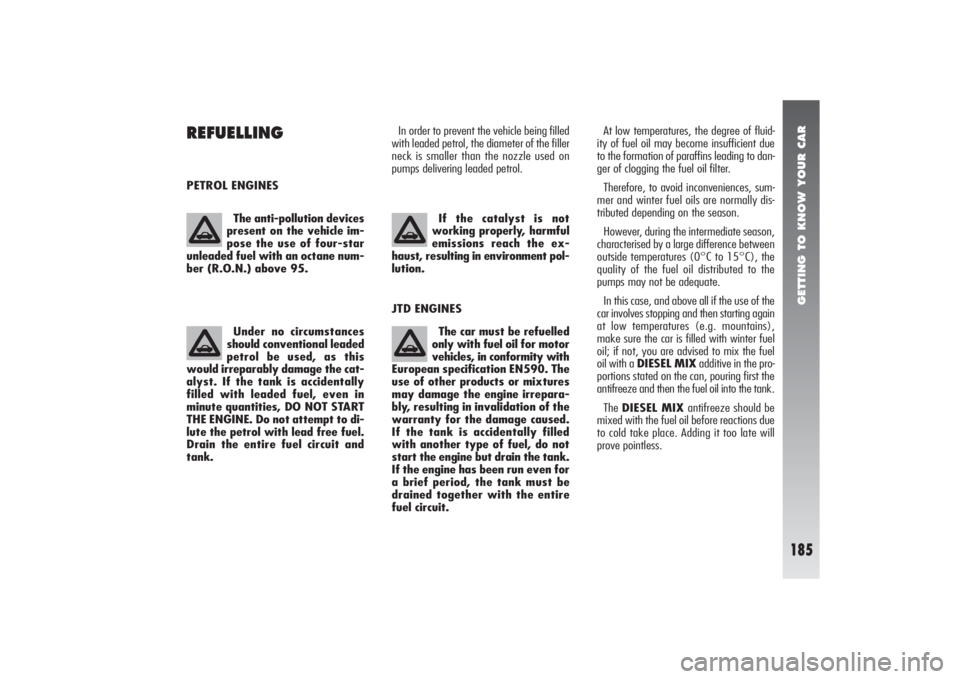
GETTING TO KNOW YOUR CAR
185
REFUELLING PETROL ENGINESIn order to prevent the vehicle being filled
with leaded petrol, the diameter of the filler
neck is smaller than the nozzle used on
pumps delivering leaded petrol.At low temperatures, the degree of fluid-
ity of fuel oil may become insufficient due
to the formation of paraffins leading to dan-
ger of clogging the fuel oil filter.
Therefore, to avoid inconveniences, sum-
mer and winter fuel oils are normally dis-
tributed depending on the season.
However, during the intermediate season,
characterised by a large difference between
outside temperatures (0°C to 15°C), the
quality of the fuel oil distributed to the
pumps may not be adequate.
In this case, and above all if the use of the
car involves stopping and then starting again
at low temperatures (e.g. mountains),
make sure the car is filled with winter fuel
oil; if not, you are advised to mix the fuel
oil with a DIESEL MIXadditive in the pro-
portions stated on the can, pouring first the
antifreeze and then the fuel oil into the tank.
TheDIESEL MIXantifreeze should be
mixed with the fuel oil before reactions due
to cold take place. Adding it too late will
prove pointless. The anti-pollution devices
present on the vehicle im-
pose the use of four-star
unleaded fuel with an octane num-
ber (R.O.N.) above 95.
Under no circumstances
should conventional leaded
petrol be used, as this
would irreparably damage the cat-
alyst. If the tank is accidentally
filled with leaded fuel, even in
minute quantities, DO NOT START
THE ENGINE. Do not attempt to di-
lute the petrol with lead free fuel.
Drain the entire fuel circuit and
tank.
If the catalyst is not
working properly, harmful
emissions reach the ex-
haust, resulting in environment pol-
lution.The car must be refuelled
only with fuel oil for motor
vehicles, in conformity with
European specification EN590. The
use of other products or mixtures
may damage the engine irrepara-
bly, resulting in invalidation of the
warranty for the damage caused.
If the tank is accidentally filled
with another type of fuel, do not
start the engine but drain the tank.
If the engine has been run even for
a brief period, the tank must be
drained together with the entire
fuel circuit.
JTD ENGINES
Page 191 of 357

CORRECT USE OF THE CAR
189
PROCEDURE FOR PETROL
ENGINESWARNINGIt is important not to press
the accelerator until the engine has started.
1) Make sure the handbrake is engaged.
2)Move the gear lever to neutral.
3)Fully depress the clutch pedal so that
the starter motor is not forced to crank the
toothed wheels of the gearbox.
4)Ensure that the systems and electrical
devices, especially if they absorb high quan-
tities of energy (e.g. heated rear wind-
screen) are switched off.
5)Turn the ignition to the AV Vposition
and release it as soon as the engine starts.
6)If the engine does not start, return the
key to the STOPposition and repeat the
operation.
WARNINGIf it is difficult to start the en-
gine do not insist with extended attempts
which may damage the catalyzer but con-
tact Alfa Romeo Authorized Services. The ignition switch is fitted with a safety
device which obliges the driver to return the
ignition key to the STOPposition before re-
peating the starting operation if the engine
does not start immediately.
Similarly, when the engine is running, the
device prevents the key being moved from
the MARto the AV Vposition.
STARTING
THE ENGINEWARNINGThe car is fitted with an elec-
tronic engine lock device. If the engine fails
to start see “Alfa Romeo CODE system”.
C C
O O
R R
R R
E E
C C
T T
U U
S S
E E
O O
F F
T T
H H
E E
C C
A A
R R
In addition to the notes
and specifications given be-
low we recommend that,
during the initial period, you do not
drive to full vehicle performance
(for example excessive accelera-
tion, long journeys at top speed,
hard braking, etc.).
To avoid useless con-
sumption of power and
possible draining the bat-
tery, never leave the ignition key
in the MAR position when the en-
gine is not running.
Running the engine in con-
fined areas is extremely
dangerous. The engine consumes
oxygen and produces carbon
monoxide which is a highly toxic
and lethal gas.
WARNING
Page 192 of 357
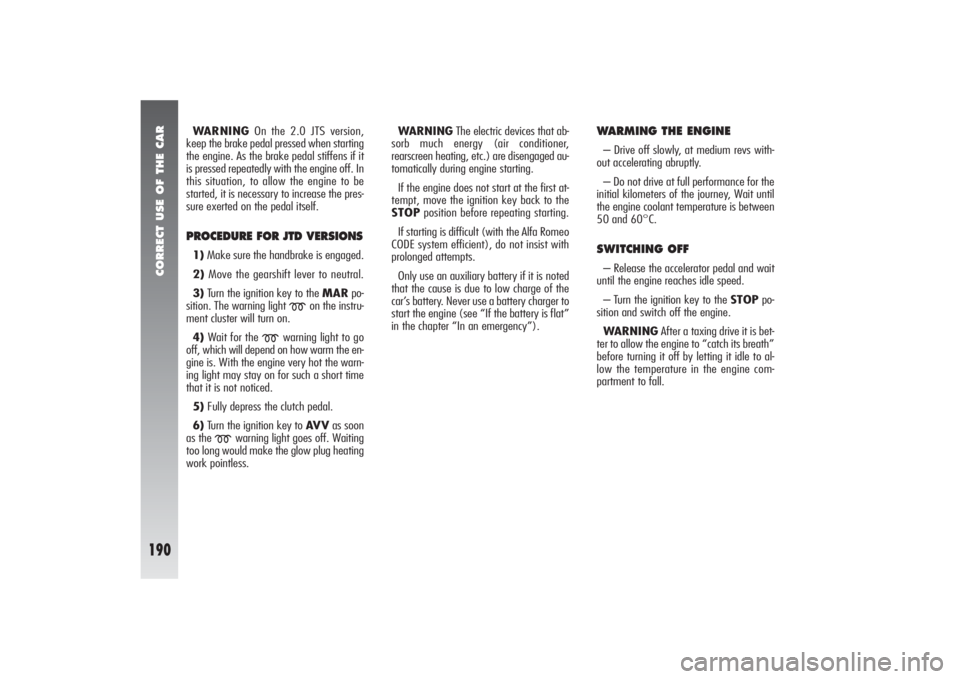
CORRECT USE OF THE CAR
190
WARNINGOn the 2.0 JTS version,
keep the brake pedal pressed when starting
the engine. As the brake pedal stiffens if it
is pressed repeatedly with the engine off. In
this situation, to allow the engine to be
started, it is necessary to increase the pres-
sure exerted on the pedal itself.PROCEDURE FOR JTD VERSIONS1)Make sure the handbrake is engaged.
2)Move the gearshift lever to neutral.
3)Turn the ignition key to the MARpo-
sition. The warning light
m
on the instru-
ment cluster will turn on.
4)Wait for the
m
warning light to go
off, which will depend on how warm the en-
gine is. With the engine very hot the warn-
ing light may stay on for such a short time
that it is not noticed.
5)Fully depress the clutch pedal.
6)Turn the ignition key to AV Vas soon
as the
m
warning light goes off. Waiting
too long would make the glow plug heating
work pointless.WARNINGThe electric devices that ab-
sorb much energy (air conditioner,
rearscreen heating, etc.) are disengaged au-
tomatically during engine starting.
If the engine does not start at the first at-
tempt, move the ignition key back to the
STOPposition before repeating starting.
If starting is difficult (with the Alfa Romeo
CODE system efficient), do not insist with
prolonged attempts.
Only use an auxiliary battery if it is noted
that the cause is due to low charge of the
car’s battery. Never use a battery charger to
start the engine (see “If the battery is flat”
in the chapter “In an emergency”).
WARMING THE ENGINE– Drive off slowly, at medium revs with-
out accelerating abruptly.
– Do not drive at full performance for the
initial kilometers of the journey, Wait until
the engine coolant temperature is between
50 and 60°C.SWITCHING OFF– Release the accelerator pedal and wait
until the engine reaches idle speed.
– Turn the ignition key to the STOPpo-
sition and switch off the engine.
WARNINGAfter a taxing drive it is bet-
ter to allow the engine to “catch its breath”
before turning it off by letting it idle to al-
low the temperature in the engine com-
partment to fall.
Page 198 of 357
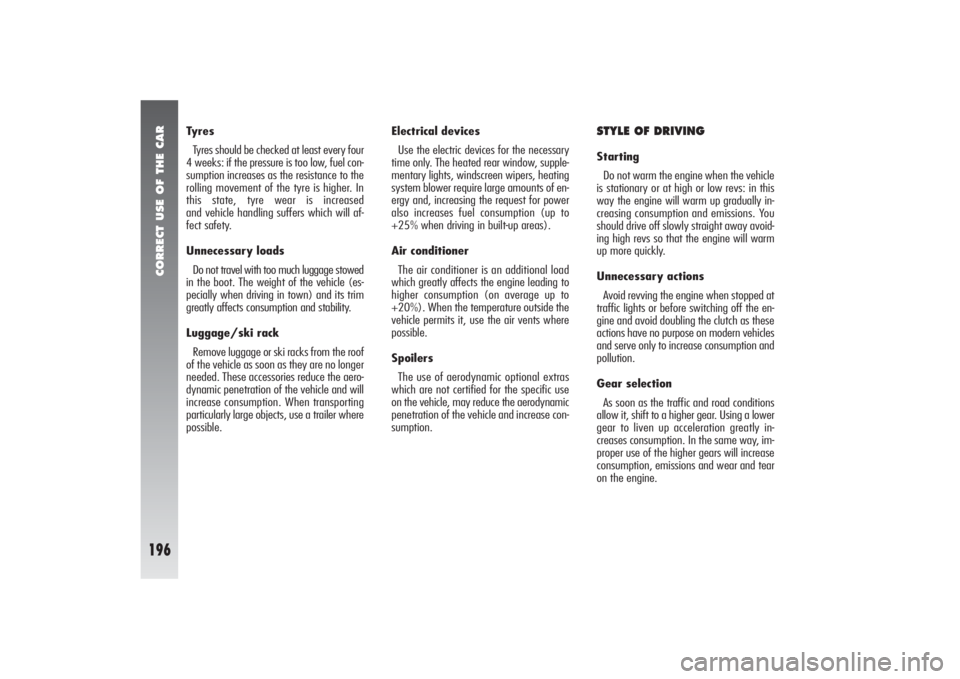
CORRECT USE OF THE CAR
196
Tyres
Tyres should be checked at least every four
4 weeks: if the pressure is too low, fuel con-
sumption increases as the resistance to the
rolling movement of the tyre is higher. In
this state, tyre wear is increased
and vehicle handling suffers which will af-
fect safety.
Unnecessary loads
Do not travel with too much luggage stowed
in the boot. The weight of the vehicle (es-
pecially when driving in town) and its trim
greatly affects consumption and stability.
Luggage/ski rack
Remove luggage or ski racks from the roof
of the vehicle as soon as they are no longer
needed. These accessories reduce the aero-
dynamic penetration of the vehicle and will
increase consumption. When transporting
particularly large objects, use a trailer where
possible.Electrical devices
Use the electric devices for the necessary
time only. The heated rear window, supple-
mentary lights, windscreen wipers, heating
system blower require large amounts of en-
ergy and, increasing the request for power
also increases fuel consumption (up to
+25% when driving in built-up areas).
Air conditioner
The air conditioner is an additional load
which greatly affects the engine leading to
higher consumption (on average up to
+20%). When the temperature outside the
vehicle permits it, use the air vents where
possible.
Spoilers
The use of aerodynamic optional extras
which are not certified for the specific use
on the vehicle, may reduce the aerodynamic
penetration of the vehicle and increase con-
sumption.
STYLE OF DRIVINGStarting
Do not warm the engine when the vehicle
is stationary or at high or low revs: in this
way the engine will warm up gradually in-
creasing consumption and emissions. You
should drive off slowly straight away avoid-
ing high revs so that the engine will warm
up more quickly.
Unnecessary actions
Avoid revving the engine when stopped at
traffic lights or before switching off the en-
gine and avoid doubling the clutch as these
actions have no purpose on modern vehicles
and serve only to increase consumption and
pollution.
Gear selection
As soon as the traffic and road conditions
allow it, shift to a higher gear. Using a lower
gear to liven up acceleration greatly in-
creases consumption. In the same way, im-
proper use of the higher gears will increase
consumption, emissions and wear and tear
on the engine.
Page 207 of 357

IN AN EMERGENCY
205
3)Fully depress the accelerator pedal and
keep it pressed. The warning light
U
will
come on for eight seconds approximately
and will then go out; now release the ac-
celerator pedal.
4)The warning light
U
begins to flash:
after it has flashed for the same number of
times as the first digit on the code of the
card, press completely and hold down the
accelerator pedal until the warning light
U
comes on (for 4 seconds) and then goes out
again; now release the accelerator pedal.
5)The warning light
U
will begin to
flash: after it has flashed for the same num-
ber of times as the second digit on the code
of the card, press completely and hold down
the accelerator pedal.
6)Repeat this procedure in the same way
for the other digits on the CODE card code.
7)After entering the last figure, keep the
accelerator pedal pressed. The warning light
U
turns on (for four seconds) and then goes
off; now release the accelerator pedal.8)A quick flash of the warning light
U
(for appr. 4 seconds) confirms that the op-
eration has taken place correctly.
9)Start the car turning the ignition key
from theMAR position to the AVV posi-
tion without returning the key to theSTOP
position.
Conversely, if the warning light
U
stays
on, turn the ignition key to STOPand re-
peat the procedure starting from point 1.
WARNINGAfter emergency starting it
is advisable to turn to an Alfa Romeo Au-
thorized Service, because the procedure de-
scribed must be repeated each time the en-
gine is started.
EMERGENCY
STARTINGIf the Alfa Romeo CODE system is not able
to deactivate the engine inhibitor, warning
lights
Y
and
U
remain lit and the engine
cannot be started. To start the engine it is
necessary to follow the emergency starting
procedure.
WARNINGYou are advised to careful-
ly read the entire procedure before carry-
ing it out.
If a mistake is made during the emergency
procedure, the ignition key should be turned
to STOPand the operations must be re-
peated from the start (point 1).
1)Read the 5-figure electronic code on
the CODE card.
2)Turn the ignition key to theMAR po-
sition.
I I
N N
A A
N N
E E
M M
E E
R R
G G
E E
N N
C C
Y Y